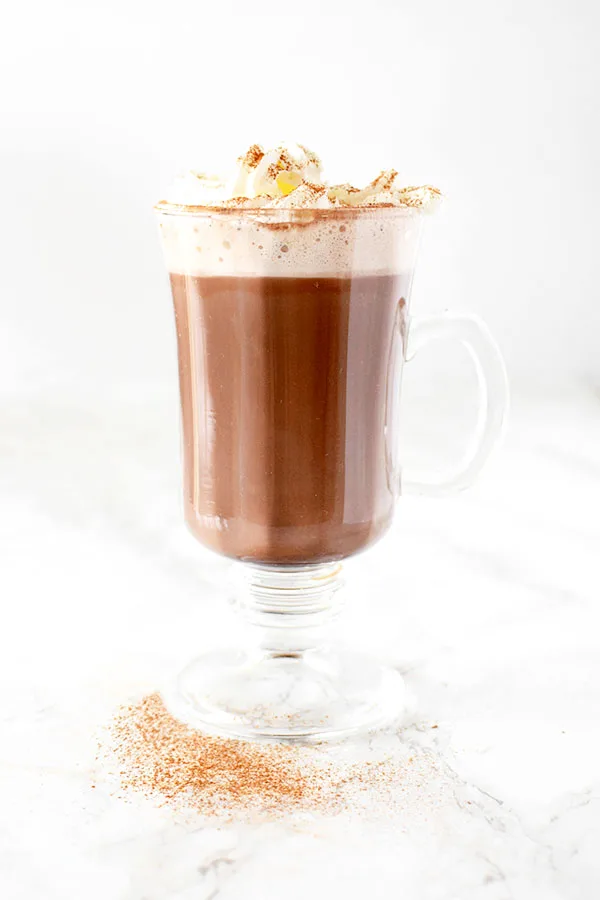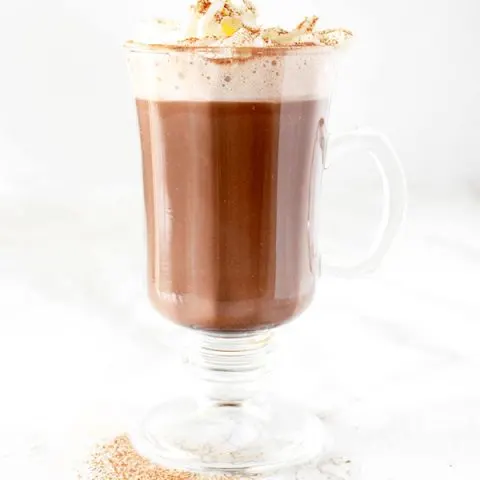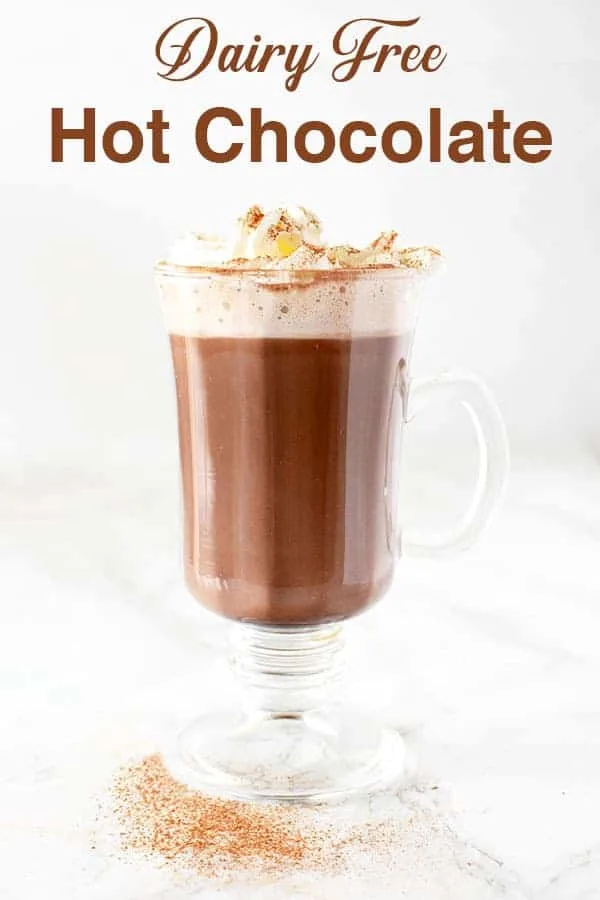Dairy free hot chocolate is made without milk and is perfect for when the weather turns cold and rainy or crisp and snowy. This recipe is very simple and uses cocoa instead of melted chocolate for ease.

I love hot chocolate. Every time I go out to a cafe with friends they order a coffee and I order cocoa.
In Israel, this means a cup of hot milk with part of a melted bar of chocolate at the bottom.
Since hot chocolate has spread throughout the world, it has a number variations.
Some are thicker, others sweeter, some use melted chocolate, while others use cocoa.
Any way you like it, it's a wonderful winter drink, and this dairy free hot chocolate is made without milk, so it can be enjoyed by everyone!
History of Hot Chocolate
The first chocolate drink was created by the Mayans around 2,500–3,000 years ago. It was served cold and made of cocoa seeds ground into a paste, then mixed with water, cornmeal, chili peppers, and more.
The Aztecs used a cocoa drink as an essential part of their culture. This version was also served cold and was said to be flavored with vanilla and other spices.
Europeans' first recorded contact with chocolate wasn't until 1502 on Columbus's fourth voyage.
Later, Spaniards came the New World in what is now Mexico where they were introduced to the chocolate drink. They brought the drink back to Europe where it became extremely popular with the upper class.
At the time, chocolate was very expensive because the beans were grown in South America and imported to Europe.
In fact, it was so expensive that cocoa was even given as a dowry when members of the Spanish Royal Family married other European aristocrats.
By the 1600's, sugar was added and cocoa was considered a luxury item among the nobility throughout Europe. At the time, spices were still a common addition to the drink and they soon found adding milk made it more palatable.
The aristocratic nature of the drink led to chocolate being referred to as "the drink of the gods." Even when it became a little more accessible to the masses when the first Chocolate House was opened in 1657, chocolate was still very expensive.
Hot chocolate has even been used as medicine until the 1800's.
They may have been on to something though, since today, there are discussions that it's abundant in antioxidants.
Which dairy free milk should I use?
Honestly, it's whatever you have on hand or prefer.
My go-to is a neutral flavored full fat oat milk because I find that they are the most similar to regular full fat milk.
Almond milk works well here, too. I personally like using an unsweetened barista almond milk because it is more similar to regular full fat milk, but whatever you have will work.
You can also use coconut milk, though it may have a subtle coconut flavor if you do. Coconut milk has more fat and is similar to using a light cream, but it won't make a noticeable difference.
I've never used soy milk, so I don't have any opinions on it, but you can use that as well.
Other Milks
I haven't tried other milks, however you are welcome to use your preferred milk to see how you like it.
Choosing your Brand
I have tried a handful of oat milk brands and I can tell you, not all oat milks are created equal.
Some brands taste like oats and have the consistency of water. Other brands have a milder taste and are slightly reminiscent of milk. Oatly and Alpro are my two go-to brands.
When I visit New York, I really like Oatly, which I find to taste like regular milk and to be a little extra creamy. I'd assume this is true in Canada too.
In Israel, I only use the barista version of Oatly, which is still more watery than the regular Oatly in the States. I expect it is the same in Europe because that is where it is imported from.
For Israel and Europe, I find the Alpro oat milk indistinguishable from the Oatly Barista. However, the Alpro "Not Milk" oat milk I find to be almost identical to milk but a little sweeter - which I like.
Cocoa
Cocoa adds a rich chocolate flavor and a nice brown color to recipes. It also helps balance sweetness in recipes, adds moisture to baked goods, and can be used to decorate food.
It's used to make recipes like brownies, chocolate cake, chocolate sauce, chocolate cookies, chocolate muffins, and chocolate cupcakes. Cocoa can also be found in surprising places like cinnamon babka (just for the purpose of coloring) and savory dishes, such as chili and mole sauces.
The color can vary depending on the type of cocoa used. Natural cocoa powder tends to create a lighter color, while Dutch-processed cocoa results in a darker one.
Cocoa also adds moisture to recipes, giving baked goods a softer and tenderer texture.
Also, when combined with baking soda, cocoa's acidity activates the leavening agent, contributing to the rise and lightness of baked goods.
Furthermore, cocoa is often used for decorative purposes. It is dusted on top of cakes, used as a coating for truffles, sprinkled over whipped cream, and to create a dusted effect for plated desserts.
WHICH TYPE OF COCOA TO USE
When a recipe calls for cocoa, always use unsweetened cocoa powder, unless specified otherwise.
This allows you to have better control of the sweetness of what you’re making.
There are three basic forms of unsweetened cocoa powder: natural cocoa powder, dutch-processed cocoa power, and raw cocoa powder.
NATURAL COCOA POWDER
Natural cocoa powder comes from cocoa beans that are fermented, roasted, processed at a higher heat, and milled into a powder.
It’s bitter with a very strong and concentrated chocolate flavor.
This cocoa powder is acidic and is often used in recipes calling for baking soda because the two react with each other to allow your baked good to rise.
This is most commonly used, and should be used, in recipes that simply say "cocoa powder."
DUTCH-PROCESSED COCOA POWDER
Dutch-processed cocoa powder starts with cocoa beans that have been washed in potassium carbonate, which neutralizes their acidity.
Since Dutch-processed cocoa powder is neutral, it does not react with baking soda.
When baking, Dutch-processed cocoa is often paired with baking powder.
Dutch-processed cocoa powder can also be used in place of natural cocoa powder in recipes that don’t require leavening.
These include sauces, hot cocoa, frostings, ice cream, pudding, etc.
If you only have Dutch-processed cocoa powder on hand, you can substitute it for neutral cocoa powder.
Just make sure to add ⅛ teaspoon of cream of tartar, white vinegar, or lemon juice for every 3 tablespoons of cocoa powder called for in the recipe.
RAW CACAO POWDER
Raw cacao powder is different from natural and Dutch-processed unsweetened cocoa powder.
It's pure powder from the cacao bean and isn't nearly as processed as either natural or Dutch-processed.
Cocoa is processed at high heat, which destroys much of the nutritional benefits of the cacao seed.
Also, cocoa powder is often alkalized during processing to reduce acidity. The result is a product that’s less bitter and more soluble when added to liquids.
Cacao powder, on the other hand, is made of fermented - not roasted - seeds that are processed at low temperatures and then milled into a powder, ensuring that its nutritional benefits and its bitter flavor are preserved.
You can use raw cacao powder in recipes that don’t specify Dutch-processed cocoa powder, however it is best not to try to.
Compared to cocoa powder, cacao powder has a stronger flavor, it is not as absorbent as cocoa powder, and it is more acidic, so it will react differently with baking soda.
Sweetened Cocoa
Sweetened cocoa contains sugar and is suitable as a hot chocolate mix, but not suitable for recipes.
What's the difference between cocoa powder and cacao powder?
Cocoa powder is made by roasting cacao beans and processing them at high heat.
Cacao powder is made by cold-pressing unroasted cacao beans. It's often considered more "raw" and retains more nutrients.
Both can be used interchangeably in recipes.
Can I use sweetened cocoa mix instead of unsweetened cocoa in baking?
No, because sweetened cocoa mix contains sugar. The added sugar can alter the sweetness and moisture of the recipe.
How do I prevent lumps when using cocoa in recipes?
Sift the cocoa into the bowl to remove lumps.
How to Store Cocoa
Store cocoa in an airtight container and keep in a cool, dark place to prevent moisture absorption and maintain flavor.
Sugar
The primary role of sugar is to be a sweetener. However, sugar also contributes to the tenderness and moistness of the baked good by absorbing and retaining moisture and helps create the golden brown color when baking as it caramelizes.
Recipes with more sugar often result in softer, moister textures. However, I learned the hard way that too much sugar leads to a sticky mess.
When it's heated, sugar caramelizes, resulting in a rich, complex flavor and a brown color. This adds both flavor and color to baked goods and is also the process in which caramel sauce, dulce de leche, caramel candies, and regular candies are made.
When used in recipes containing yeast, the sugar is eaten by the yeast, producing carbon dioxide and causing the dough to rise.
Sugar also acts as a preservative in jams, jellies, and fruit preserves by reducing water activity and preventing microbial growth.
There are many different types of sugar, including white sugar, brown sugar, vanilla sugar, powdered sugar, turbinado sugar, and demerara sugar.
When a recipe calls for “sugar” without specifying anything else, it's referring to regular white sugar.
White Sugar
White sugar (sometimes called granulated sugar, table sugar, or white granulated sugar) is made of either beet sugar or cane sugar, which has undergone a refining process.
It is the easiest to find and most commonly used.
Brown Sugar
Brown sugar is white sugar with molasses added to it.
It is commonly used in chocolate chip cookie recipes, and it’s rare for a recipe that calls for brown sugar not to also call for white sugar as well.
When a recipe calls for “brown sugar” but doesn’t specify what type (light or dark), it is referring to light brown sugar.
In my recipes, you can use whatever type of brown sugar you have on hand, whether it is dark brown sugar, light brown sugar, or demerara sugar - which is very common in Israel.
Just keep in mind that the flavor and color will be slightly different, depending on what you choose to use.
Turbinado Sugar
Turbinado sugar is better known as "raw sugar." But, despite this name, the sugar is not really “raw.”
Instead, it's partially refined sugar that retains some of the original molasses.
The term "raw sugar" may also give off the impression that it is somehow healthier.
In reality, turbinado sugar is nutritionally similar to white sugar.
Demerara Sugar
Demerara sugar is very popular in Israel and is especially delicious in tea, but is also used for baking.
Unlike white sugar, demerara sugar undergoes minimal processing and retains some vitamins and minerals.
However, it is still not much healthier than white sugar.
Vanilla Sugar
Vanilla sugar is not very common in the States. However, it is common in Israel and parts of Europe.
This is sugar that sat for an extended period of time with vanilla beans, giving it a vanilla flavor.
Caster Sugar
This type of sugar is common in the United Kingdom.
It has a grain finer than white (granulated) sugar and larger than powdered sugar.
Caster sugar is often called for in recipes for delicate baked goods like meringues, souffles, and sponge cakes.
You can use a 1:1 conversion rate between caster sugar and white (granulated) sugar.
Powdered sugar
Powdered sugar, sometimes known as confectioners’ sugar, is a sugar with a powdered texture.
This sugar is rarely used for baking. Instead, it is used for dusting desserts and making frosting, icing, and glazes.
In some countries, you can also find powdered vanilla sugar.
It is made the exact same way regular vanilla sugar is made. However, the sugar used is powdered instead of granulated.
Vanilla Extract vs Vanilla sugar
In my recipes, I don’t specify what kind of vanilla to use.
The reason for this is that in the States, vanilla extract is exclusively used.
Meanwhile in Israel, along with many European countries, vanilla sugar is common.
In most, if not all recipes, both vanilla extract and vanilla sugar can be used.
In recipes where vanilla sugar can be used instead of extract, you can replace them 1:1.
Replacing Sugar with Honey
If you’d prefer to use honey instead of sugar, you can do so with pretty good results.
Honey can be two or even three times as sweet depending on the honey, so for every 1 cup of sugar, you can use ½ to ⅔ cup honey.
Since honey adds liquid, you need to remove some to balance it out. For every cup of honey, remove a ¼ cup of liquid.
Also, it burns faster than granulated sugar, so you want to lower the baking temperature by 25 F. In addition, check it early and often to avoid burning or overbaking.
How to Store Sugar
Sugar should be stored in an airtight container to prevent clumping and moisture absorption, and kept in a cool, dry place.
Why is there salt?
Salt really brings out the flavor in other things such as sugar. If you're on a no sodium diet, you can leave it out. However, if not, it's best to add it.
Hot Chocolate without Milk

This recipe for dairy free hot chocolate is made without milk, very simple to make, and can easily be adapted to taste. It only needs a few ingredients and does not require melting chocolate. While this recipe is only for one cup, you can easily multiply it to make more.
Ingredients
- 1 cup dairy free milk (235 milliliter) [see note ]
- 1 to 2 tablespoons unsweetened cocoa powder
- 2 tablespoons white sugar
- Pinch of salt
Optional Additions
- pinch cinnamon
- ¼ teaspoon vanilla
- dairy free whipped cream, for serving
- marshmallows, for serving
Instructions
- In a small saucepan, over medium heat, bring dairy free milk to a simmer.
- Whisk in cocoa, sugar, salt, and cinnamon and/or vanilla if desired. Stir until well incorporated. Remove from heat.
- Pour hot chocolate into a mug and top with whipped cream or marshmallows.
Notes
If topping with whipped cream, you can sprinkle cinnamon or chocolate shavings on it to make it look extra pretty.
Nutrition Information:
Yield:
1Serving Size:
1Amount Per Serving: Calories: 305Total Fat: 7gSaturated Fat: 4gTrans Fat: 0gUnsaturated Fat: 2gCholesterol: 24mgSodium: 134mgCarbohydrates: 50gFiber: 2gSugar: 30gProtein: 11g

Malia
Sunday 16th of October 2022
Thanks for this recipe. I thought it was pretty good, and it was definitely quick to make!
ElissaBeth
Friday 4th of November 2022
I'm glad to hear you enjoyed it :)